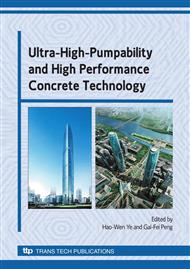p.262
p.267
p.272
p.278
p.283
p.289
p.296
p.303
p.309
Effect of Aggregate Volume Fraction on the Charge Passed of Mortar and Concrete
Abstract:
Charge passed of mortars with different aggregate volume fractions was tested according to ASTM C1202, and the differential expression of the Ohm law was introduced to explain the relationship between charge passed data and aggregate fractions.Cl- penetration depth of the corresponding mortars and concretes was measured to illustrate the influence of the aggregate volume fraction on their chloride permeability. It was shown that the charge passed of mortar was negatively correlated with aggregate volume fractions, and high aggregate fraction bearing concrete with low charge passed did not necessarily mean low permeability. As a result, the influence of aggregate fraction on charge passed should be taken into consideration when charge passed data was employed to evaluate Cl- permeability of concrete.
Info:
Periodical:
Pages:
283-288
Citation:
Online since:
January 2009
Authors:
Price:
Сopyright:
© 2009 Trans Tech Publications Ltd. All Rights Reserved
Share:
Citation:


